This post contains affiliate links. If you buy something from one of our links we may earn a commission. Thanks
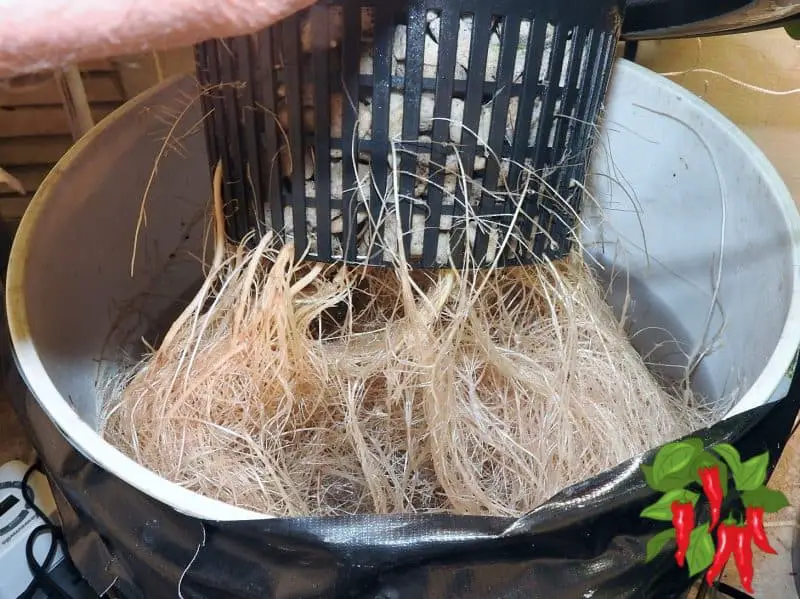
Discover the joys of an apartment kitchen garden! Learn how to grow fresh veggies and herbs in small spaces for a sustainable, healthy lifestyle.
Apartment Garden Key Takeaways:
- An apartment kitchen garden is:
- A compact and efficient way to grow fresh vegetables, herbs, and fruits in limited spaces using containers, hydroponics, or window boxes.
- Ideal for urban dwellers seeking a sustainable lifestyle.
Start Your Apartment Kitchen Garden
Starting on an apartment kitchen garden journey brings a unique blend of challenges and rewards.
It’s an adventure that transforms your living space into a haven of greenery and freshness.
Whether you’re a seasoned gardener or a budding green thumb, this guide will help you cultivate a thriving garden in the heart of your apartment.
I started an apartment kitchen garden with lettuce, tomatoes, and peppers.
So now I’m growing a hydroponic garden in an apartment and I will show you how you can grow an indoor apartment garden too.
Apartment gardening is rewarding and it is not as complicated as some people make it sound.
Even if you don’t have a green thumb you can start an indoor garden and grow your own vegetables and skip going to the grocery store so often.
So the first step is to find some garden space and get started. I won’t lie it does take a little effort to plant and water a garden but growing your own produce is still a great option.
The good news is even if you don’t have a sunny window or are gardening in an apartment without a balcony you can use an LED grow light and get great results without sunlight.
Most apartments are low on natural light and the hours of direct sunlight go down significantly during the winter.
You can grow your own food with a simple container garden even if you are a complete beginner.
It’s a great way to grow fresh herbs and some of the easiest vegetables in a limited space.
The best thing is getting to enjoy the fruits of your labor. Trust me it is a very satisfying experience.
Also, one advantage I have with my small kitchen garden is that it’s summer all year round. Although I am using DWC you don’t have to do it that way.
Using coco coir is another great method of gardening. I use it a lot for growing vegetables too.
Here is a video of my apartment kitchen garden. I break down what you need to know to have a productive and satisfying kitchen garden in your apartment or any room you choose.
Beginner gardeners can do this and start their own garden even in an urban environment.
A hydroponic garden can grow plants without soil. You can grow veggies year-round with hydroponics.
Growing hydroponic vegetables gives you faster growth and higher yields than soil.
You can grow hydroponic vegetables indoors and outdoors. Indoors you will need a grow light. You will also need plants or seeds, a container, and nutrients.
If you have a sunny spot with south-facing windows you can grow veggies there even on a windowsill.
If you are lucky enough to have an apartment patio or balcony you can grow plants outdoors during warm weather and bring them in when it gets cold.
Apartment balcony gardens are fantastic for growing edible plants like tomatoes or bell peppers best vegetables to grow on an apartment balcony.
Unfortunately, although patio gardens are one of the best places for growing vegetables they are not an option for me.
So I have a kitchen garden that only has a north-facing window so using an LED grow light is essential.
If space is really limited you might consider growing in window boxes.
You might talk to your landlord and find out if rooftop gardens are an option for you.
Apartment Kitchen Garden – Growing A Hydroponic Garden In An Apartment
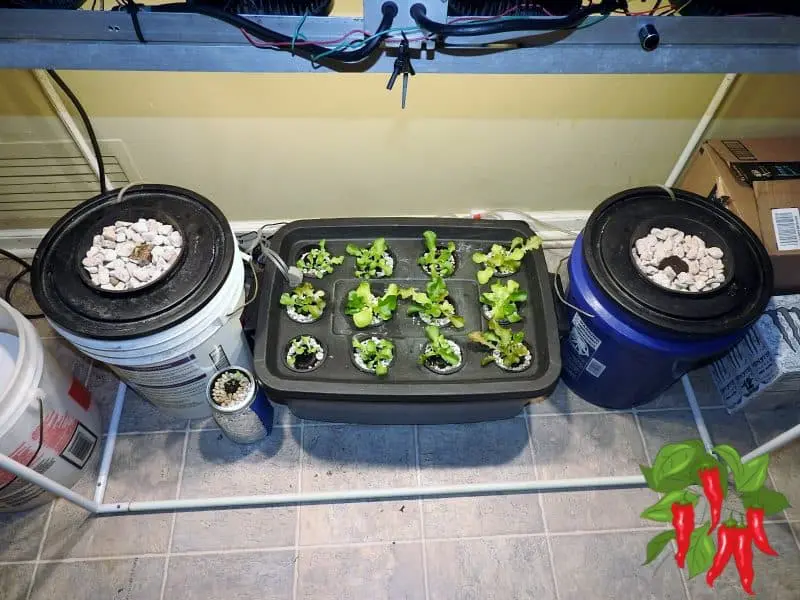
I want to show you my apartment kitchen garden. I’ve been growing my hydroponic garden in this small space inside my kitchen.
I want to show you and tell you a little bit about it so you can do it too.
Kratky Method Lettuce – Easy Passive Hydroponics
I have a tub of lettuce that’s using the Kratky method. It’s just a 10-gallon tote with a nutrient solution in it. The lid is cut out to hold my 3-inch net pots.
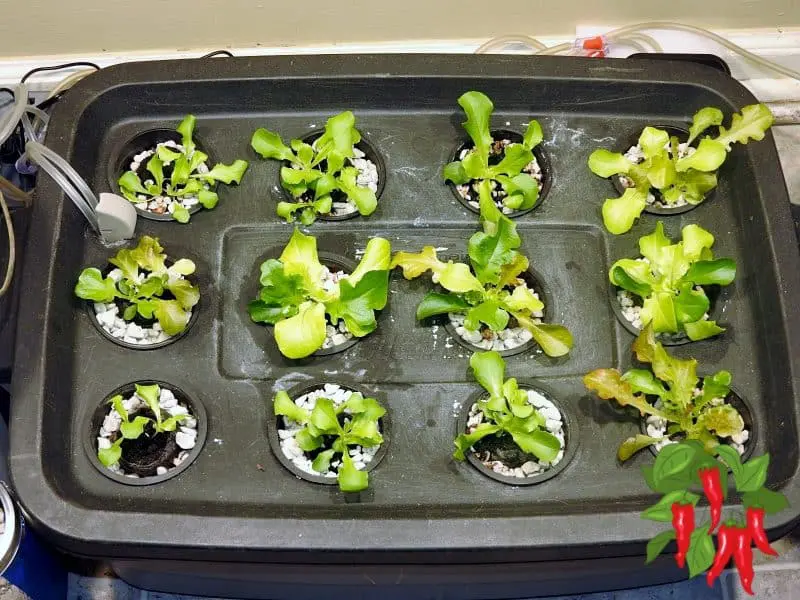
I planted my seeds in jiffy pellets and set them in the pots. The pellets are surrounded by an inert media like hydroton or perlite.
The lettuce pots have multiple plants because lettuce seeds are small.
I’m going to thin it out but I want to let the plants get a little bigger first. Then I’ll get some salad greens out of it.
I have this lid open and if look closely, you’ll see a wick in each net pot. Each net pot is filled with grow stones and you can see the roots are just starting to come out of the pots.

What will happen is they will get into the water and start to feed on the nutrient solution. Eventually, the part above the water will become air roots.
The roots in the water will be the plant’s feeder roots and as the name implies, they feed nutrients to the plant.
But plants also need oxygen and the air roots help provide this, while also transferring nutrients from the feeder roots.
Once the air roots are established they don’t get covered back up in the water again. They stay alive because they are in a very humid environment.
With the Kratky system, you’re only supposed to fill your tote once when you start. And when the water is gone the grow is done.
So it’s best adapted to fast-growing plants like lettuce or other greens.
But I added some air stones to my tote and that will allow me to maintain the water level or add more water without killing the roots.
Without aeration, once they turn into air roots, you can’t cover them in water.
Because there’s a good chance they’ll suffocate. I don’t want that to happen obviously
So the Kratky method is really adaptable and I even have a small Kratky lettuce plant in a mason jar.
And yes, you can do it too. Hydroponics can be really simple.
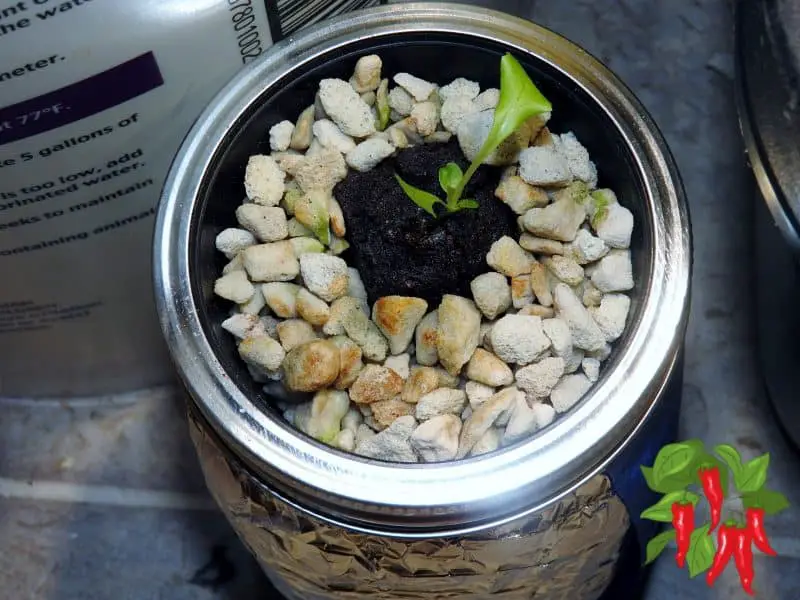
Right now all my plants are still small. so I don’t have a terribly huge amount of stuff to show you.
DWC Bubble Buckets – For Tomatoes And Peppers
I also have two deep water culture buckets or bubble buckets as they’re sometimes called.
You can see in one that I have a tomato plant and I have an air stone in there, so there are lots of bubbles to aerate the water.
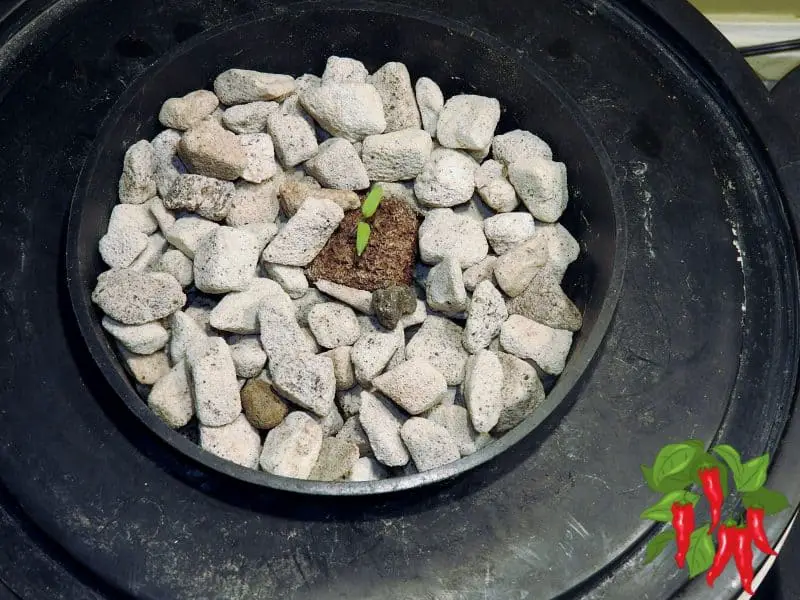
Here Is Why They Call Them Bubble Buckets
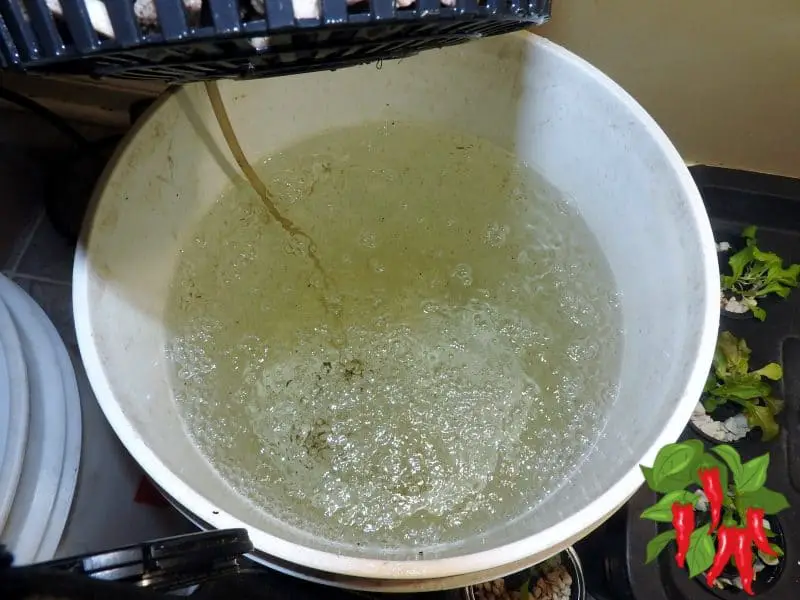
I have another 5-gallon bucket on the other side that has a pepper plant in it. But it has not popped up yet even though it’s pretty close.
Building A Frame To Hang My Lights
What I did here is build a frame so I could hang my light above my plants with adjustable light ratchets.
This is an old grow tent frame, but you could easily make a light hanger from PVC pipe.
So you don’t need to have a grow tent to do this. Although these would do much better in a grow tent.
But this grow is in my kitchen and it is small. So I only have a little space here. I set the frame alongside and under a window.
It’s working just fine, but it’s a little bit tight in here. I have to work around it, but I can deal with it.
Now the lettuce will be done long before the tomatoes or the peppers are.
Then it will probably come out, or I might plant something else in there.
I have some bush cucumber seeds that I’d really like to give a try and I might put one in this tote.
Anyway, I know lots of people live in an apartment and a lot of people don’t have access to an outside garden, but they still want to grow stuff.
So I’m here to show you that you can grow vegetables in an apartment and even do it in a small kitchen.
Hydroponic Kitchen Vegetables
I like to grow hydroponically because that means I don’t have to deal with soil.
But you can just grow in pots and saucers with a soil mix and a lot of people do it that way too.
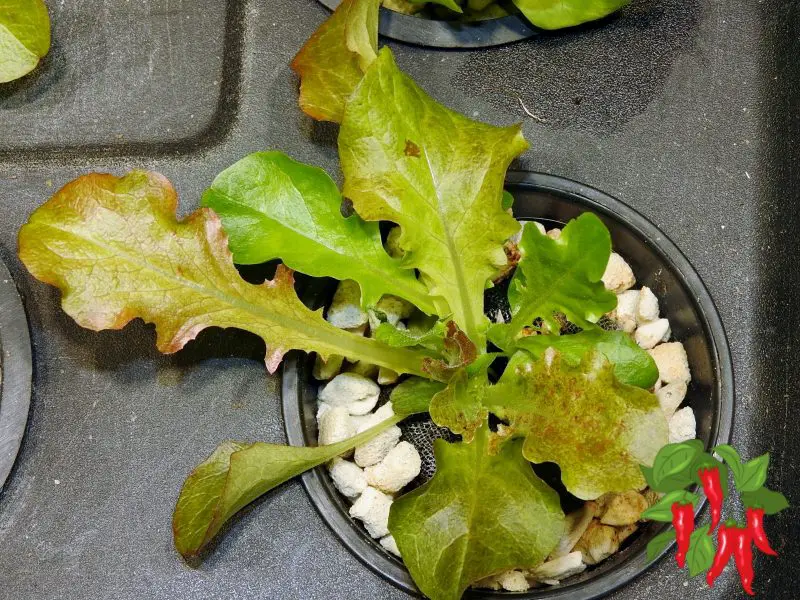
But I think hydroponics is better because it makes plants grow and finish faster, and they generally do better in it.
I have systems that I can automate, where I can put my watering on a timer.
So if I want to go away for a weekend I can. If I’m growing in pots they have to be watered.
Somebody’s got to be there to do it, and I’ve heard a ton of horror stories about asking a neighbor to do it.
So that’s not a rabbit hole that I want to go down.
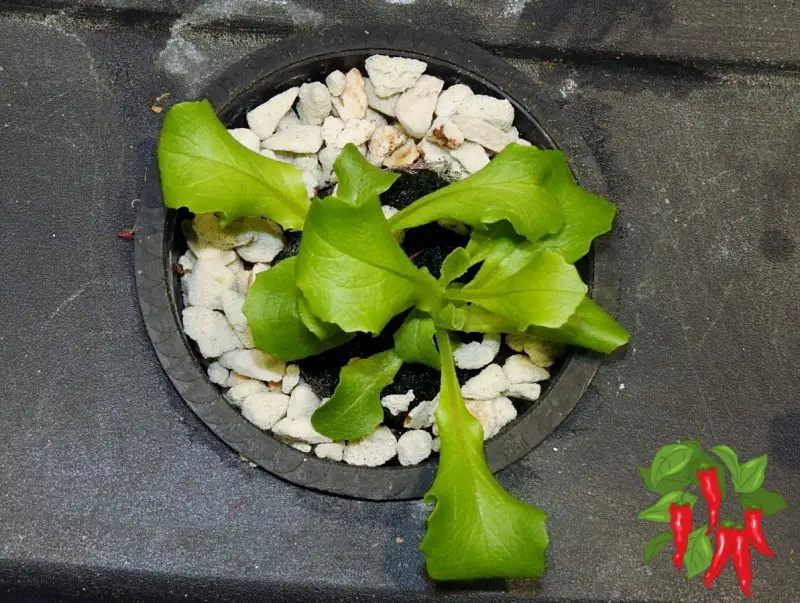
But you know any space in your apartment can grow vegetables. I mean you could just get an AeroGarden or two and grow in them.
They work great. I have one, it’s sitting on my coffee table. You can put an AeroGarden just about anywhere.
They’re idiot-proof. Anyone can successfully grow herbs or lettuce in there.
But they’re made for small plants. So you can’t grow a full-sized tomato or a full-sized pepper in an AeroGarden and that’s what I want.
I really like my green peppers. I like to put them in salads. I also like to cook with them. You know I think they add a great flavor to things.
I like my tomatoes too, but I don’t want those little tiny marble-sized tomatoes. I want some tomatoes that I can slice and throw a couple of slices on top of a burger.
To do that I need a bigger system. So I’m doing this bucket DWC or deep water culture.
Now you can hook buckets together and feed them with a separate reservoir.
But I didn’t do that here. Because I’m in an upstairs apartment and I don’t want to risk having any water leaking into the apartment down below.
So with an individual bucket, there are no holes or fittings for water to leak out from, and all I have to do is maintain the water level in the bucket.
It works kind of the same as in the Kratky. You let it go down a few inches, so you develop some air feeder roots. Then you let the rest of the roots stay in the nutrient solution.
It’s really pretty easy. Although these plants are small, you can’t tell their true potential right now. But once they get going they will start to grow fast.
They will yield a couple of weeks before something similar would yield in soil.
So like any plant, when it’s small, it’s really slow growing. I mean it takes time, and the first couple of leaves usually aren’t even their true leaves. They’re what are called cotyledon leaves.
Then from there, it starts to develop regular leaves and it’s kind of like a snowball rolling down a hill.
If you’ve ever seen that in a cartoon, it starts off slow, and then it gets bigger and bigger, and then it gets big really fast.
That’s what plants do. They’re very slow at first, and then they reach a point where they have enough roots and they have enough leaves to collect enough light.
Then they can really explode in growth. You can get really explosive growth in deep water culture
Now, this 5-gallon bucket with the pepper plant is white, and it shouldn’t be. I’m going to need to cover it. You don’t want any light getting into a reservoir, because it will cause algae to grow, and that’s not a good thing.
So I will be covering this, and if you’re going to do the Kratky method, it’s the same thing. You want an opaque tote because you don’t want light getting in.
You’ll notice on the lid I have airlines going in, and the hole is kind of big, so it’s filled in with a piece of foam, and that way no light will get in.
You know, this lettuce is really getting to a point where it’s going to start to take off. I am going to have to thin it really soon.
What I have in this tote are six butter crunch lettuce plants, and that’s the first three in the bottom row, and then I have three up on top too.
Then down the middle row and in the two corners on the right are leaf lettuce, and it was a mixed seed pack, so there are different types of lettuce growing in each pot.
I will thin it out probably in about a week, and then I’ll have something I can throw in a sandwich or a salad.
Is It Worth Growing Hydroponic Vegetables In An Apartment?
It’s really worth growing hydroponic vegetables. At least it is to me. I mean people ask is it worth growing vegetables in an apartment, and all I can say is yes.
For one thing, it’s very satisfying to eat something that you’ve grown yourself.
Another thing you know is that these plants have not been sprayed with anything, and you sure can’t say the same thing about the stuff in the supermarkets.
A lot of times you’ll be listening to the news, and you hear a story about coliform bacteria contaminating greens. They tell you people are getting sick and you need to throw them away.
That’s another problem you won’t have unless you don’t wash your hands when you leave the bathroom, and I’m pretty sure you do so that’s another plus.
You know it’s fun and it’s educational, growing hydroponic vegetables.
It’s a great project to share with your kids if you have kids. Or share it with your friends if you have any friends, and I’m sure you do.
So I really recommend giving it a try. You know, if nothing else, you can buy an AeroGarden and set it up somewhere. They will even fit on a shelf or countertop.
It’s pretty much a foolproof hydro system. But because of the smaller-sized reservoir, it’s limited mostly to herbs and really small patio tomatoes.
So it’s a great hydroponic kit, but it’s limited. If you want full-sized vegetables, you’re going to need to use a bucket system, or else you need to grow them in large pots.
But you can turn your apartment into a really nice vegetable garden. There are a lot of ways to do it.
My way is just the way that I’m doing it here. You can set up a grow tent somewhere and grow in that.
You can grow in soil or grow with hydroponics, it’s your choice.
But there is one thing I do want to mention because it’s important. You’re going to need a light.
You Will Need An LED Grow Light
You know you can grow on a patio outdoors and that’s okay as long as it gets sun.
But in the winter you’re going to need to move inside, and for that, you’re going to need a light.
Even in the summer, most apartments are too dark to really grow vegetables well.
Vegetables are photosynthetic. That means they take light and make stuff from it, and what they make from it is food.
Bear in mind most vegetables were grown outdoors. They have adapted to growing with a lot of sunlight and you don’t have that in your apartment. So you need a light.
COBS Work Great But Not As Efficient
Now this light I’m using is called a COB, which stands for chip on board.
It is a light that has chips that are made of hundreds of small LED lights. They work well, but not as well as the newer LED lights.
So this is a homemade COB, and it’s about 200 watts at the wall. I just want to say if you go and look for a grow light you want a LED.
I just happen to have this light, and you can still buy them. But they’re just as expensive as a good LED from Horticulture Lighting Group and I use those in my closets.
Here’s How To Grow Hydroponic Tomatoes and Peppers In A Closet
They are made in the USA they are beyond a doubt the best lights you can buy dollar for dollar. But they’re expensive. But you can also buy a cheaper one.
The ones I looked at that I like best are the Spider Farmer lights. They are pretty much a copy of the HLG lights.
They have really good Samsung diodes in them. They’re dimmable and they’re available in a lot of different sizes. And they are more affordable.
Fluorescent Shop Lights
Yes, you can grow with a fluorescent shop light, and they’re cheaper, but you have to replace the bulbs every year. They won’t give you enough light for tomatoes, peppers, or cucumbers.
A LED grow light will give you the most light using the least amount of electricity, so that’s the way to go.
Buyer Beware
What you need to know is a lot of the Chinese manufacturers blow up the numbers of the output of their lights.
What they do is add up the total wattage of all the chips. So if they have a thousand five-watt chips, they’re going to say it’s a 5,000-watt LED.
Well, it’s really not, because they don’t run them at full power. You know, I don’t see any that run at more than half power.
How To Measure A LED
So the way you measure an LED is the watts at the wall. It’s how much electricity they pull when you plug them in.
They should provide those specs if they don’t, don’t buy that led.
Usually, they’ll provide a PAR chart, so you can get an idea of how high to hang your light because most of you probably don’t want to spend a lot of money on a light meter.
Another option is that there are some apps on iPhone, and I think there’s one also for Android. I think it’s called Photone or something like that, and you can take readings with that.
How Much Light Do You Need?
Anyway, the lights are going to be important, especially for a high-light plant like tomatoes.
They measure light in a greenhouse in what’s called DLI or day light integer, and that’s the total amount of light a plant gets over the time it’s lit.
Now a plant like tomatoes needs about 30 DLI. A plant like lettuce needs about half of that. Most herbs also use that much. But a plant like cannabis can take as much as 60 DLI.
So there are varying light levels for plants, and that’s why you can get away with growing lettuce with a fluorescent if you want.
But it won’t really give you enough light to flower a tomato or pepper very well.
They might do it, but you won’t get peak performance. Honestly, it’s just not worth it, to change the bulbs every year.
For high-light plants under LED lights, you will need about 30 watts per square foot.
If you are only growing low-light plants you can get away with less.
200-250 watts is all you will ever need for a 2 x 4-foot area. Buy an LED with a dimmer so you can adjust light levels. You can also do this by raising or lowering your light
LED lights can last for 50,000 hours or more, so it’s the way to go. If you’re going to grow indoors, you are going to need to provide light. So be prepared to do that.
If you have veggies out on your patio, and you want to move them inside when it starts to get cold, you will still need to put them under a light. A window is not going to do it.
I don’t want to discourage you from getting started, but you know I want you to be successful.
So what you need to do is make sure you have a good light source, and make sure you have enough room for whatever it is you want to grow.
Honestly, if you have enough light, you can grow anything inside that you could grow outside.
If you don’t have a lot of space you want to maximize its production. You are doing square-foot gardening now and using vertical gardening.
The AeroGarden can fit just about anywhere and is a perfect solution if space is tight. You can grow lettuce and herbs.
You can grow greens, you can grow small patio tomatoes, and I’ve seen them grow chili peppers in it. You just have to get the right plants that are really dwarf.
Anyway, in closing, I turned my kitchen into a vegetable garden and you can too. So I want to encourage you to start growing vegetables indoors.
It’s a great hobby, yeah, it costs a little bit of money upfront, but it will give you back more than that in satisfaction and in food.
Apartment Garden FAQs
Navigating the world of apartment kitchen gardening can raise many questions.
From choosing the right vegetables to understanding the basics of indoor gardening, here are answers to some frequently asked questions that will help you turn your apartment into a green oasis.
Q. Can you have a vegetable garden in an apartment?
A. Yes, you can have a vegetable garden in an apartment. Utilize spaces like balconies, windowsills, or any area with sufficient light.
Container gardening and hydroponics are great options for growing vegetables in limited spaces.
Q. How do I start an indoor garden in my apartment?
A. To start an indoor garden in your apartment, choose a suitable location with adequate light, select appropriate containers or hydroponic systems, and pick plants suited for indoor conditions. Ensure regular watering and proper nutrient supply for your plants.
Q. What food can I grow in my apartment?
A. In an apartment, you can grow a variety of foods including herbs like basil and mint, leafy greens like lettuce and spinach, and vegetables like tomatoes, peppers, and cucumbers.
Choose dwarf, compact, or bush varieties suitable for small spaces.
Q. How do you grow herbs and vegetables in an apartment?
A. Grow herbs and vegetables in an apartment by using containers or hydroponic systems.
Place them in a location with sufficient light, maintain a consistent watering schedule, and ensure they receive the right nutrients and care.
What vegetables are easy to grow in an apartment?
A. Easy vegetables to grow in an apartment include lettuce, spinach, radishes, cherry tomatoes, and peppers.
These plants generally require less space and are forgiving for beginners.
Apartment Gardening Conclusion
Starting an apartment kitchen garden is an enriching and sustainable way to bring freshness into your home. It’s not just about growing food; it’s about nurturing life and enjoying the satisfaction of harvesting your own produce.
Remember, space shouldn’t limit your gardening dreams. With the right approach, even the smallest apartment can become a lush, productive garden. So why wait? Embrace the joy of apartment gardening today and reap the rewards of your green thumb!
Apartment Kitchen Garden Resources
Here is more information about using an LED grow light:
Growing Vegetables Indoors With Lights [The Truth You Need To Know] (indoorvegetablegrower.com)
Here is an article about using and setting a grow tent for vegetables and LED grow lights:
Using A Grow Tent For Vegetables [ Ultimate Quick-start Guide ] (indoorvegetablegrower.com)
Here is a helpful easy to understand guide on small scale hydroponics that will work in an apartment. Small-scale hydroponics | UMN Extension
Read more: Learn to grow lavender indoors
Read more about Growing Fig Trees Indoors.
Read more: Vivosun 5 Tier Stackable Planter








